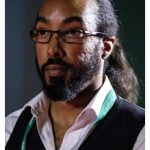“Failure shouldn’t stop you”: an interview with healthcare innovator Hilton Bennett
How to Be an Entrepreneur, Lesson One: Time Commitment
By Nicole Carter
Auxiliary Label Staff
Hilton Bennett is a young man to admire. While studying at VCU, he has been a husband and a father of three. Now 38, he is pursuing a master’s in product innovation.
VCU has filed for four patents in the past year for technology on which he has been the primary mechanical engineer. One of these patents is for a device that can digitally tell an anesthesiologist the pressure difference in the spinal column. This allows for more precise epidurals with fewer side effects.

An avid rock climber, as a freshman in the VCU Engineering program Bennett wanted a safe way to practice traditional climbing indoors. He started building a device to solve his problem. Two years ago, Bennett started Native Heights Climbing Solutions, a company with the goal of simulating traditional rock climbing for indoor climbing gyms. VCU’s Cary Street Gym will be his first client; he says it will be the first indoor climbing gym in the world to have a device that allows practicing and training for traditional climbing indoors.
I had the opportunity to chat with Bennett over pizza after he spoke at the Entrepreneurship in Healthcare Series at VCU School of Pharmacy, coordinated by faculty member Dayanjan Wijesinghe, Ph.D.
Auxiliary Label: What do you think is unique or challenging about innovating in the healthcare industry?
Hilton Bennett: [Laughs] Challenging first: It’s the time. The time commitment is longer for medical devices. If you only consider the FDA process, minimum it’s going to be two to five years, averages can be longer depending on what class the device falls in, what it’s being used for, and who’s going to use it. It’s kind of daunting to think about.
There’s an argument that technology is growing at a speed that we can’t keep up with. We could design a device but then the technology advances beyond it before it even comes to market.
I assume it takes a lot of money to run trials. Do you raise money or partner with a bigger institution?
For our epidural device, we partnered with VCU Health’s Anesthesiology Department, as the problem for ideation originated from their ranks. Three former anesthesiology residents, now all anesthesiologists, and current instructor Michael Kammerman taught us the epidural procedure and we practiced the procedure with the regular epidural needle and syringe. Once we had a prototype, we were able to use their simulation models for testing. It was an invaluable resource to test in their lab. I mean, normally, to get to that level of testing, you’d have to spend several thousand dollars. For us, it was free, and I think the experience is what we really hope for as engineering students.
What have you done when you’ve been faced with an obstacle?
After I get feedback … I decide if it’s meant to be overcome. Then it’s time to make the next iteration to the design. I usually take time throughout the week to focus on higher priority projects and just everything else. Then I’ll start back — not to square one, but to a specific point, and think back though how it’s designed and how someone would use it. We’ll make very small changes. We look at the shape and the size, how it fits in your hand, the screw placement, and how the electronics fit inside. Most obstacles were; in my opinion, meant to be overcome, but also to create a check and balance in what shouldn’t be an easy process.
What advice do you have for other entrepreneurs?
Know that it will take time. Every device is not going to work, and failure shouldn’t stop you; it should encourage you to continue working. And make sure that you’re passionate about it in a way that drives you to work at it in your spare time, but not in a way that prevents you from being open to changes or to scrapping everything and starting over.
Auxiliary Label is a student-created blog examining pharmacy life, education and research at the VCU School of Pharmacy from a student perspective. It is overseen by Greg Weatherford, the school’s director of communications. Contact him here.
Categories Auxiliary Label, Student news